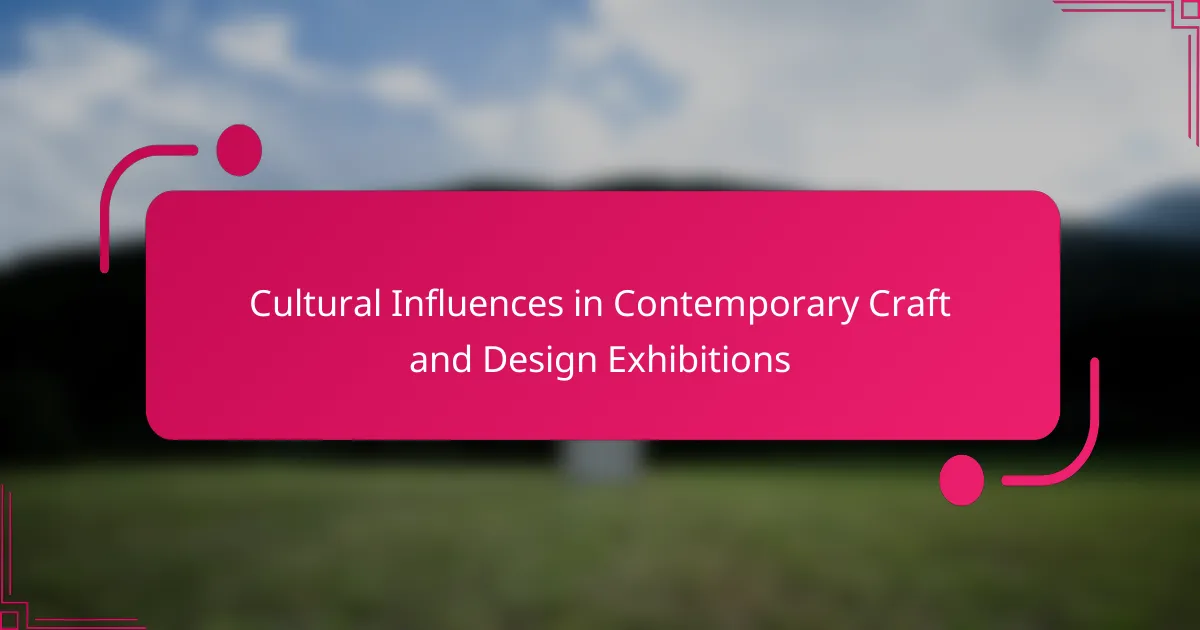Cultural influences significantly shape contemporary craft and design exhibitions. Globalisation fosters cross-cultural exchange, while technology enhances creativity. Regional interpretations reflect local traditions and societal values. Curators face challenges in representing diverse narratives and engaging audiences effectively.
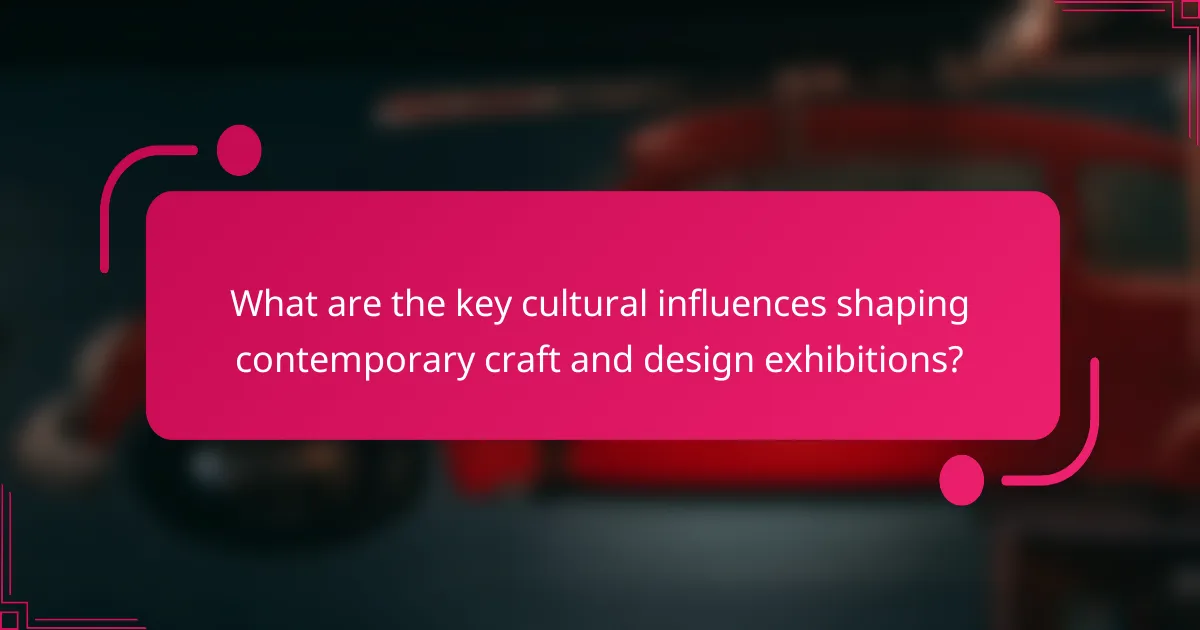
What are the key cultural influences shaping contemporary craft and design exhibitions?
Cultural influences shaping contemporary craft and design exhibitions include globalisation, technological advancements, and social movements. Globalisation fosters cross-cultural exchange, allowing diverse artistic expressions to merge. Technological advancements enhance creativity through new tools and platforms, enabling innovative designs. Social movements, such as sustainability and inclusivity, drive artists to reflect contemporary values in their work. These influences create dynamic exhibitions that resonate with current societal trends.
How does globalisation impact the themes of these exhibitions?
Globalisation significantly enriches the themes of contemporary craft and design exhibitions. It fosters cross-cultural exchanges, allowing diverse artistic expressions to emerge. Artists incorporate global influences, reflecting a blend of local traditions and international trends. This synthesis enhances the narrative depth of exhibitions, showcasing how interconnectedness shapes cultural identities. As a result, audiences experience a broader perspective on craftsmanship and design, emphasising collaboration and innovation across borders.
Which local traditions are often showcased in contemporary exhibitions?
Local traditions often showcased in contemporary exhibitions include artisanal crafts, indigenous textiles, and community rituals. These elements highlight cultural heritage and promote local identities. Exhibitions frequently feature traditional pottery techniques, folk art, and culinary practices, emphasising their relevance in modern design. As a result, audiences gain insights into the fusion of past and present in contemporary craftsmanship.
What role do social movements play in influencing design choices?
Social movements significantly influence design choices by reflecting societal values and addressing cultural issues. Designers often draw inspiration from movements advocating for social justice, sustainability, and inclusivity. For instance, the rise of eco-conscious movements has led to increased use of sustainable materials in design, promoting environmental awareness. Additionally, movements focused on diversity have encouraged designers to create more inclusive products that cater to a broader audience. This alignment with social movements not only enhances relevance but also fosters community engagement and cultural dialogue within contemporary craft and design exhibitions.
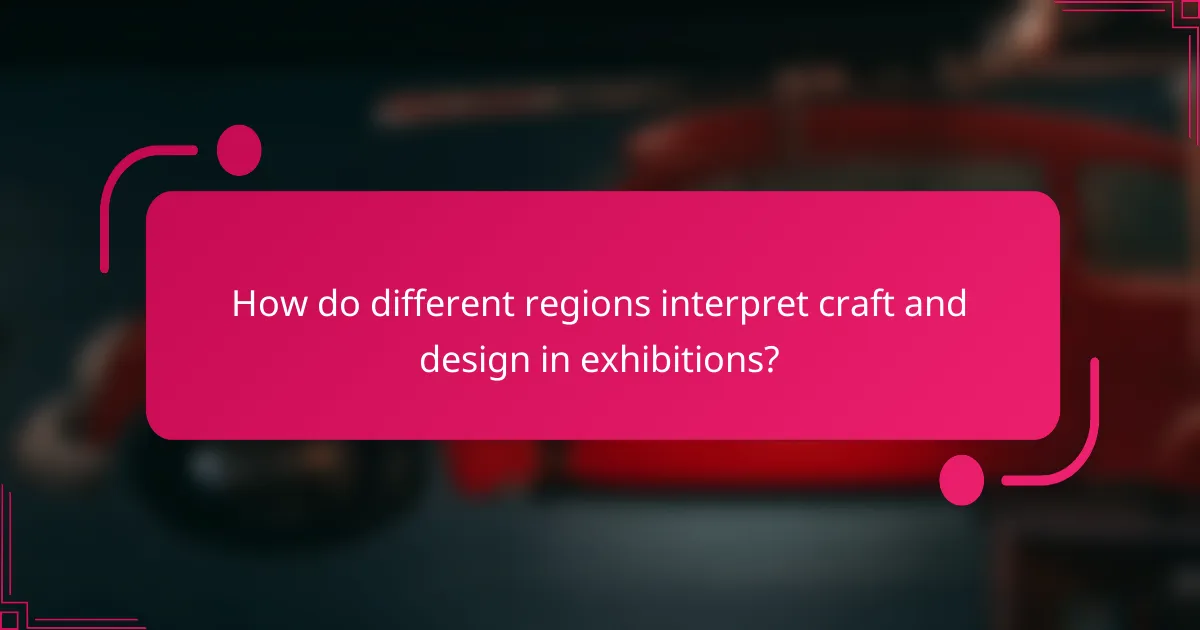
How do different regions interpret craft and design in exhibitions?
Different regions interpret craft and design in exhibitions through unique cultural lenses. These interpretations reflect local traditions, materials, and societal values. For instance, Scandinavian exhibitions often emphasise minimalism and functionality, while African exhibitions highlight vibrant colours and communal storytelling.
Regional influences shape the themes presented, with Asian exhibitions frequently showcasing intricate craftsmanship and spiritual significance. Additionally, Western exhibitions may focus on innovation and contemporary issues. The diversity in these approaches enriches the global dialogue on craft and design, fostering cross-cultural appreciation.
Understanding these regional interpretations enhances the viewer’s experience, offering deeper insights into the values and practices that inform contemporary craft and design. This cultural context is essential for curators and artists aiming to connect with audiences effectively.
What unique materials are favoured in North American craft exhibitions?
North American craft exhibitions often favour unique materials such as reclaimed wood, natural fibres, and indigenous clay. These materials reflect cultural heritage and contemporary sustainability practices. Reclaimed wood showcases environmental consciousness, while natural fibres highlight traditional craftsmanship. Indigenous clay emphasises the importance of cultural identity in craft.
How does European craftsmanship reflect local cultural narratives?
European craftsmanship embodies local cultural narratives through techniques, materials, and designs that reflect regional identities. Artisans often draw on historical traditions, infusing their work with stories and values unique to their communities. For example, Italian ceramics showcase vibrant colours and intricate patterns inspired by local folklore. Similarly, Scandinavian woodworking emphasises minimalism and functionality, mirroring the cultural ethos of simplicity and practicality. This connection between craft and culture fosters a deep appreciation for heritage, encouraging sustainable practices and the preservation of traditional skills. As a result, contemporary craft and design exhibitions become platforms for storytelling, celebrating the diversity of European cultural expressions.
Which Asian design philosophies are prevalent in contemporary exhibitions?
Contemporary exhibitions often showcase Asian design philosophies such as minimalism, wabi-sabi, and feng shui. These philosophies emphasise harmony, simplicity, and the beauty of imperfection.
Minimalism focuses on essential forms and materials, reducing clutter to highlight craftsmanship. Wabi-sabi celebrates transient beauty, valuing the natural ageing process and imperfections in objects. Feng shui integrates spatial arrangement to promote positive energy and balance in environments.
These philosophies influence various design elements, from architecture to product design, reflecting a deep respect for tradition and nature. As a result, contemporary exhibitions feature works that resonate with cultural heritage while embracing modern aesthetics.
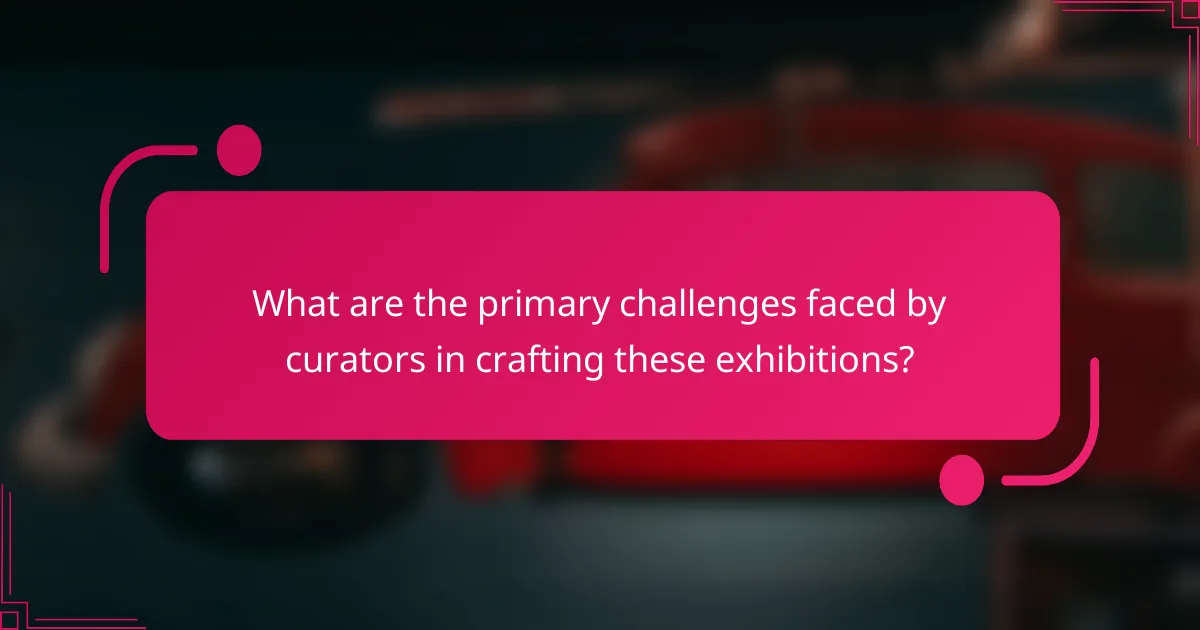
What are the primary challenges faced by curators in crafting these exhibitions?
Curators face several primary challenges in crafting exhibitions on cultural influences in contemporary craft and design. These include balancing diverse artistic perspectives, securing funding, and addressing audience engagement.
Curators must navigate the complexities of representing various cultural narratives authentically. This requires in-depth research and collaboration with artists, which can be time-consuming. Additionally, funding limitations often constrain the scope of exhibitions, impacting the quality and range of artworks displayed.
Audience engagement presents another challenge. Curators need to create interactive and educational experiences that resonate with diverse audiences. This involves innovative display techniques and outreach strategies to attract visitors and foster appreciation for contemporary craft and design.
How do financial constraints affect exhibition themes and materials?
Financial constraints significantly limit the themes and materials used in exhibitions. Budget restrictions often lead to simplified concepts and less expensive materials. Curators may prioritise accessibility and community engagement over elaborate installations. This shift can result in more meaningful, relatable themes that resonate with local audiences. As a result, financial limitations can foster creativity and innovation within the constraints.
What strategies are used to engage diverse audiences effectively?
Effective strategies to engage diverse audiences include incorporating inclusive narratives, utilising culturally relevant themes, and fostering interactive experiences. These approaches ensure representation and resonance with various cultural backgrounds. For example, integrating local artists can enhance authenticity and relatability. Additionally, employing multilingual resources can improve accessibility and understanding. Engaging audiences through collaborative workshops and community feedback enhances participation and connection.
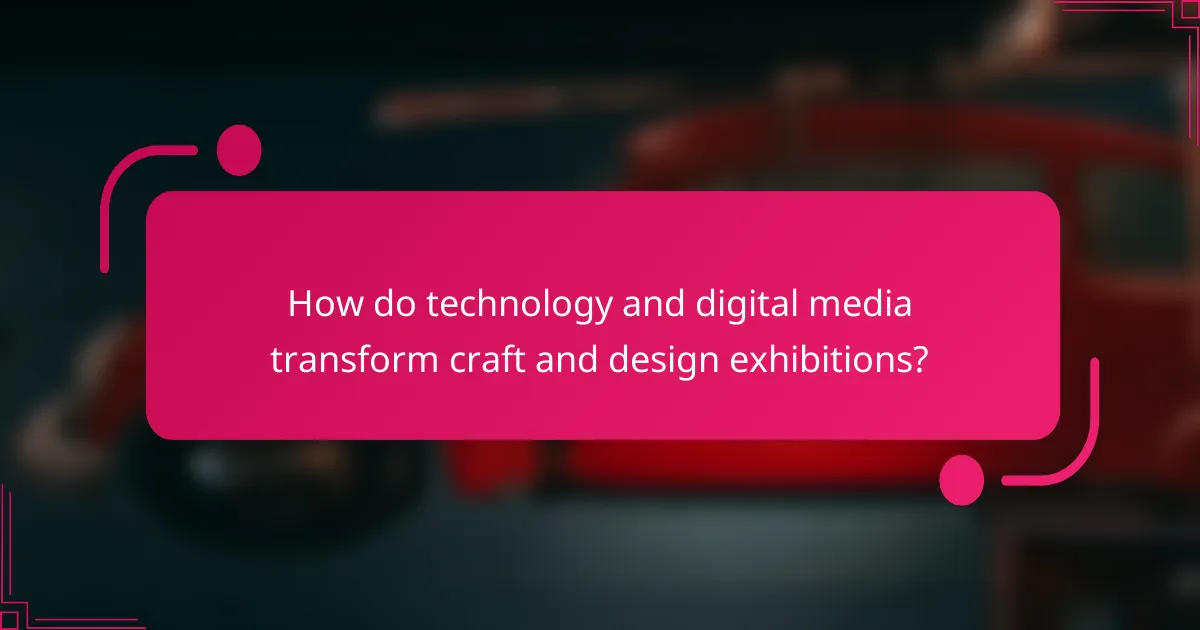
How do technology and digital media transform craft and design exhibitions?
Technology and digital media significantly transform craft and design exhibitions by enhancing engagement and accessibility. Interactive installations and virtual reality experiences allow audiences to immerse in the creative process, bridging the gap between artists and viewers. Digital platforms also facilitate broader outreach, enabling global participation and diverse cultural influences. Additionally, data analytics provide insights into visitor preferences, informing future exhibitions and improving overall visitor experience.
What innovative formats are emerging in virtual exhibitions?
Innovative formats in virtual exhibitions include immersive 3D environments, interactive storytelling, and augmented reality experiences. These formats enhance viewer engagement and allow for deeper exploration of cultural influences in contemporary craft and design. Virtual reality galleries, for instance, enable users to navigate spaces as if they were physically present, fostering a unique connection to the artwork. Additionally, live-streamed artist talks and workshops create real-time interaction, enriching the exhibition experience. These emerging formats reflect the evolving nature of digital exhibitions, emphasising interactivity and accessibility.
How does social media influence audience interaction with exhibitions?
Social media significantly enhances audience interaction with exhibitions by fostering engagement and accessibility. It allows real-time communication, enabling visitors to share experiences, provide feedback, and connect with artists. Platforms like Instagram and Facebook amplify exhibition visibility, attracting broader audiences. Additionally, social media can create a sense of community among attendees, encouraging discussions and collaborations. This interactive element transforms traditional viewing into a participatory experience, making exhibitions more dynamic and relevant.
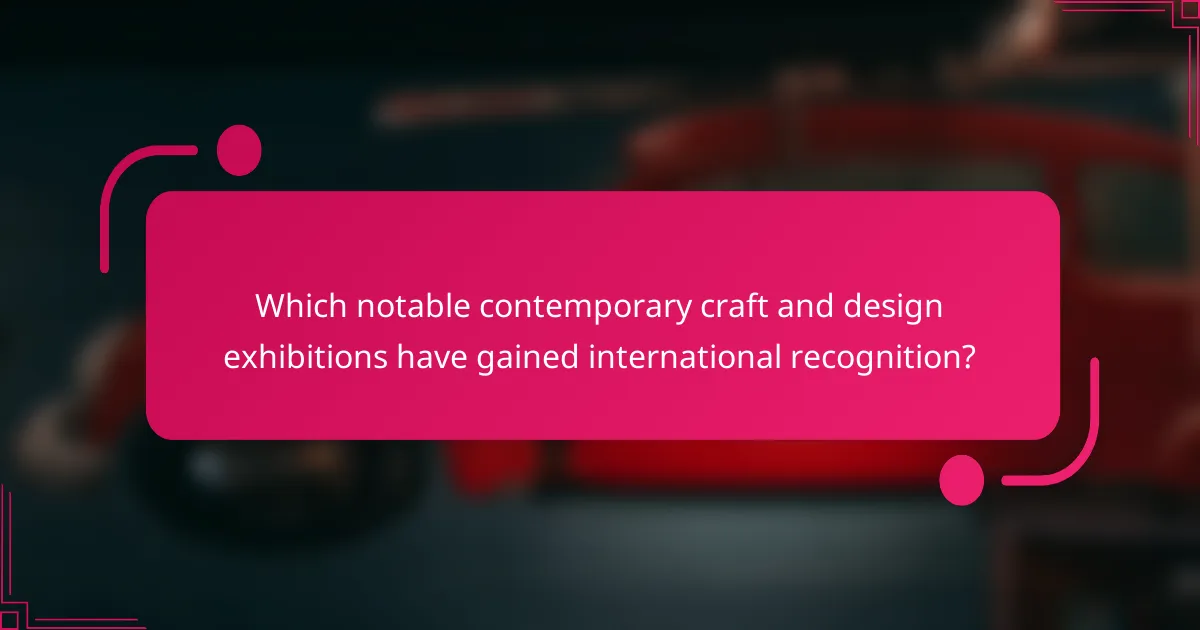
Which notable contemporary craft and design exhibitions have gained international recognition?
Notable contemporary craft and design exhibitions that have gained international recognition include the Venice Biennale, Salone del Mobile in Milan, and the London Design Festival. These events showcase innovative works and highlight cultural influences in the field. The Venice Biennale is renowned for its global reach and diverse participation, while Salone del Mobile emphasises cutting-edge design trends. The London Design Festival celebrates creativity across various disciplines, attracting worldwide attention. Each exhibition reflects unique attributes of contemporary craft and design, contributing to their esteemed status.
What unique attributes set apart award-winning exhibitions?
Award-winning exhibitions stand out due to their innovative design, cultural relevance, and audience engagement. Unique attributes include the integration of local traditions, the use of sustainable materials, and interactive installations that invite participation. These elements create immersive experiences that resonate with diverse audiences. Additionally, award-winning exhibitions often feature collaborations with local artisans, enhancing authenticity and community connection.
How do these exhibitions reflect current societal issues?
Cultural influences in contemporary craft and design exhibitions often mirror current societal issues by addressing themes like identity, sustainability, and social justice. These exhibitions serve as platforms for artists to express concerns relevant to today’s world. For example, many exhibitions highlight the impact of climate change through innovative materials and techniques that promote sustainability. Additionally, they often explore cultural identities, reflecting the diverse backgrounds of artists and their communities. This engagement fosters dialogue and awareness around pressing issues, making art a powerful medium for social commentary.
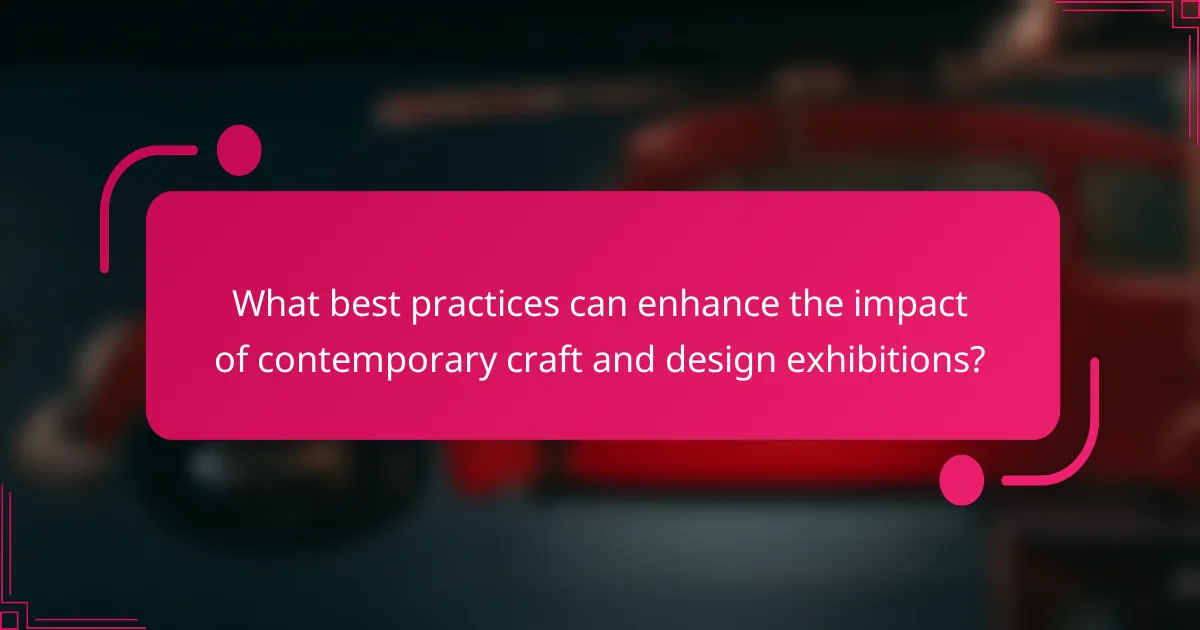
What best practices can enhance the impact of contemporary craft and design exhibitions?
Engaging the audience through interactive elements enhances the impact of contemporary craft and design exhibitions. Incorporating workshops, live demonstrations, and artist talks fosters a deeper connection with the craft. Curating diverse cultural influences enriches the narrative, showcasing unique attributes of different traditions. Utilising digital technology, such as virtual tours and augmented reality, broadens accessibility and engagement. Collaborating with local communities creates relevance and supports unique local craftsmanship, enhancing the exhibition’s overall impact.
How can curators effectively collaborate with artists and communities?
Curators can effectively collaborate with artists and communities by fostering open communication and mutual respect. Establishing trust encourages creative exchanges and shared goals. Regular workshops and meetings help align visions and enhance community engagement. Utilising feedback from both artists and audiences leads to more inclusive exhibitions. Finally, showcasing diverse cultural narratives enriches the overall experience, making it more relevant and impactful.
What common mistakes should be avoided in exhibition planning?
To avoid common mistakes in exhibition planning, focus on clear objectives, audience engagement, and logistical details. Neglecting these areas can lead to ineffective displays and poor visitor experiences.
1. Failing to define clear goals for the exhibition can result in a lack of direction.
2. Ignoring the target audience’s preferences may diminish their interest and engagement.
3. Overlooking logistical aspects, such as installation timelines and budget constraints, can disrupt the planning process.
4. Not considering cultural sensitivities in design can alienate specific demographics.
5. Skipping thorough evaluations of previous exhibitions can lead to repeating past mistakes.
Which metrics are essential for evaluating the success of an exhibition?
Key metrics for evaluating the success of a cultural exhibition include visitor attendance, engagement levels, sales data, media coverage, and visitor feedback. These metrics provide insight into audience reach and satisfaction.
| Metric | Description |
|———————–|———————————————–|
| Visitor Attendance | Total number of attendees |
| Engagement Levels | Interactions per visitor |
| Sales Data | Revenue generated from merchandise |
| Media Coverage | Number of articles or features published |
| Visitor Feedback | Surveys measuring satisfaction and insights |
